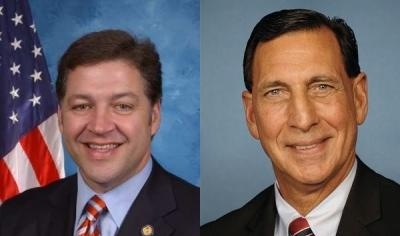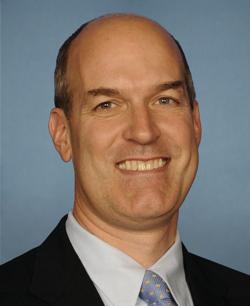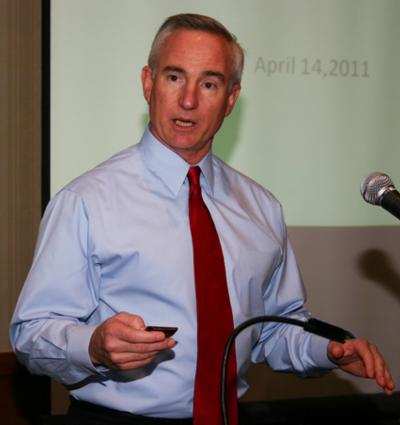Full Transportation Committee Looks Ahead To FAA Reauthorization Bill
The House Transportation Committee held a hearing Tuesday as it begins the process of crafting the next FAA reauthorization bill. And while it was not mentioned specifically by the committee's leadership, privatization of Air Traffic Control was one of the undercurrents of the hearing.

"The world has changed since 1958 (when the FAA was created) in numerous ways and it is time to take stock of where we are and what we need for the decades ahead," said committee chairman Bill Shuster (R-PA) (pictured, left) in his prepared opening remarks.
"Today’s hearing is an opportunity for us to learn what issues we should consider as we plan for the next FAA reauthorization and beyond. It will not come as a surprise to any pilot who has waited in a long line of planes on the tarmac, or to any passenger who has watched the departures board as his or her flight is delayed or cancelled, that our system can be better."
Shuster said that there have been many attempts at making substantive changes to the agency over the years. "Both President Clinton and President Bush sought to reform the FAA in order to ensure the level of air traffic control service that Americans deserved. While each had varying degrees of success, neither was able to implement long lasting, transformative reform," he said.
"As air travel continues to grow and our airspace becomes increasingly more complex, we must ensure that the infrastructure, rules, processes, and laws are up-to-date and able to withstand the test of time. To do that, we must make sure that the FAA is properly structured to carry out modernization efforts and operate as efficiently as absolutely possible."
Shuster also chastised the agency for the slow pace of the implementation of NextGen. "In report after report, the Inspector General of the Department of Transportation (IG) – and the Government Accountability Office for that matter – has identified costly problems with the FAA’s management of air traffic control modernization programs. For example, in 1998, the IG found that in carrying out one modernization program, the FAA had wasted a billion dollars in taxpayer money. Sadly, the IG will testify today that this is not uncommon. He notes that of 15 major acquisitions that were ongoing as of September 2013, eight included acquisition cost increases amounting to $4.9 billion, and eight experienced delays. This waste is the result of the FAA’s inability to plan effectively and manage programs in a way that delivers reasonable, cost effective, and beneficial outcomes.
"As we move forward, all options are on the table. However, anything we do in the FAA Reauthorization needs to be done together, to ensure that our work helps lay a foundation for the brightest possible future of U.S. aviation," Shuster said. "America invented aviation, we have been the leader in aviation innovation, but we are starting to lose our edge. We cannot allow this to happen and we must act now."
Aviation subcommittee chair Frank LoBiondo (R-NJ) (pictured above, right) Echoed many of those sentiments. "Let’s look at the long-term challenges our aviation sector is facing and be bold and decisive in addressing them through an open exchange of ideas. It’s my hope today to learn what issues we in Congress need to think about as we look ahead to the next FAA Reauthorization and beyond to ensure we continue to have the safest system possible that also secures America’s leadership in this vital and growing global industry," he said.
The Wall Street Journal reports that John Engler, president of the Business Roundtable, said during the hearing that the FAA has a history of "slow and uncertain" progress in implementing NextGen. The former Governor of Michigan pointed out that privatized air traffic control systems "funded directly" by their users as are found in places like Australia, Canada, Germany, and the U.K. have been shown to be effective. But such plans do require operators of commercial, business, and private aircraft to pay for those services, he said.
Airlines for America CEO Nicholas Calio also said that "we just might find answers outside the U.S.," and urged the congress to look at systems in other countries.

Congressman Rick Larsen (D-WA) (pictured), the ranking Democrat on the aviation subcommittee, said that the FAA suffers from "a political problem," and laid at least part of the blame at the feet of the Republicans in the Congress
"The FAA must have funding certainty and the flexibility to invest. When we talk about the FAA’s challenges in running programs smoothly, we need to recognize that the agency’s problem is not simply a management problem. I think the agency has a political problem.
"Last year’s efforts by some in Congress to force the federal government off of the fiscal cliff were not only a catastrophe for the everyday operation of the airspace," Larsen said in his prepared remarks.
"They also caused great harm to NextGen efforts. Just as the FAA must do better, so must we in Congress. And I hope today’s hearing will give us a solid path for how we should progress with a strong bipartisan bill.
"I know conversations have been going on among stakeholders about air traffic reform.
"But reauthorization must not be a science experiment. If we resolve to go big in this bill with significant air traffic reforms, we must do so methodically—with a clear statement of the problem we are trying to solve and a clear understanding of how to solve it without compromising safety in any way.
"In addition to airspace management, we also cannot lose sight of the work that needs to be done to safely implement UAS into the airspace, improve certification, and streamline FAA facilities."

Capt. Lee Moak (pictured), president of the Air Line Pilots Association, Int’l (ALPA) today challenged Congress to advance long-term, sustained funding for modernizing the national airspace and to end government policies that put U.S. airlines at a competitive disadvantage internationally. The call came in testimony before the U.S. House Committee on Transportation and Infrastructure.
“When it comes to issues of modernizing the airspace in the United States, I’m happy to report that it’s on the verge of becoming a success story,” said Capt. Moak. “We’ve made considerable progress, during turbulent times, in spite of dealing with issues like sequestration and operating under 23 short-term extensions.”
“There’s no question that our nation’s airspace needs an overhaul to prepare for the influx of passengers projected to arrive in our terminals and the continued growth of the cargo industry,” said Capt. Moak to lawmakers. “There’s also no question that there is room for growth in our aviation industry. I’d say that we agree on 95 percent of how to achieve that growth. But the 5 percent we disagree on lies in how to pay for it, and who pays for it.”
ALPA’s president underscored the union’s concern about a lack of commitment in dedicating federal resources to modernization. As an example of the lack of consistency, Capt. Moak pointed to the investment of $100,000 per aircraft made by several airlines to install controller-pilot datalink communications equipment, only to have the FAA cut funding for the program because Congress couldn’t support it.
“That put our airlines out millions of dollars and left them with useless equipment on aircraft,” Capt. Moak told the committee. “If our airlines invest in new equipment on our airliners, they have to see a return on their investment—not a different plan, from a different administration.”
 ANN's Daily Aero-Term (04.20.24): Light Gun
ANN's Daily Aero-Term (04.20.24): Light Gun Aero-News: Quote of the Day (04.20.24)
Aero-News: Quote of the Day (04.20.24) ANN's Daily Aero-Linx (04.21.24)
ANN's Daily Aero-Linx (04.21.24) Aero-News: Quote of the Day (04.21.24)
Aero-News: Quote of the Day (04.21.24) ANN's Daily Aero-Term (04.21.24): Aircraft Conflict
ANN's Daily Aero-Term (04.21.24): Aircraft Conflict





